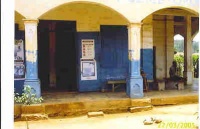| People | Forum | Koforidua | Geography | Photos 1 | Photos 2 | Neighbours | Video | Squidoo |
Ghana news ô ô ô ô Ghana country ô ô ô ô Good day, it is 4. 12. 2025, Thursday in 49. week. ô ô ô ô Ghana business ô ô ô ô Ghana sport ô ô ô ô
Oyoko
Location
Oyoko is a small community, which lies 4 miles north of Koforidua, the Eastern Regional capital along the main road from Koforidua to Kumasi.
People
According the last population census held in 2000, the population was 6400 people with children between 6 -18 years constituting about 30% with high fertility rate among women. Most of the people are peasant farmers with few working in the public sector.
People living in Oyoko - Koforidua now are from mixed cultures. About 70% of the population are Asantes with the rest being Ewes, Northerners and other minority tribes
History
Oyoko was one of the Sekyere towns which migrated to present day New Juaben in Eastern Region under the leadership of King Asafu Agyei, when Nana Kofi Karikari (King of Ashantis) and his Kumasi forces in Ashanti Region attacked Juaben which is also in Ashanti Region and its allies in October 1875. The Sekyere towns which formed part of the allies were Effiduase and Asokore. Whilst Effiduase and Asokore were led by their chiefs during the sojourn, Nana Adjei Bohyen the Oyokohene (Chief of Oyoko)Oyoko was one of the Sekyere towns which migrated to present day New Juaben in Eastern Region under the leadership of King Asafu Agyei, when Nana Kofi Karikari (King of Ashantis) and his Kumasi forces in Ashanti Region attacked Juaben which is also in Ashanti Region and its allies in October 1875. The Sekyere towns which formed part of the allies were Effiduase and Asokore. Whilst Effiduase and Asokore were led by their chiefs during the sojourn, Nana Adjei Bohyen the Oyokohene (Chief of Oyoko) had died during the onslaught. It was his nephew Kwadwo Kesse who led the migrants from Asante - Oyoko in Ashanti Region to present day New Juaben in the Eastern Region and they came with their sacred stool (Kro and Dabo Stool)
Nana Kwadwo Kesse became the first chief of Oyoko, New Juaben in 1878, he died in 1908 and was succeeded by Nana Yaw Sempeh, who ruled for 20 years and died in 1928. He was succeeded by Nana Twum Moro who abdicated the stool after 6 months rule. There was some litigation over the choice of the next occupant of the stool until 1930 when Nana Owusu Akromah was installed Oyokohene (Chief of Oyoko). He died in 1944 and was succeeded by Nana Kwadwo Kesse II who abdicated in 1948. He was succeeded by Nana Owusu Ansah who also died in 1955 and was succeeded by Nana Sempeh Asare II who ruled until 1976 when he was destooled. Nana Opoku Nkawie II succeeded Nana Sempeh Asare II in 1975 and abdicated in 1979. He was succeeded by the current chief Nana Kodua Kesse II in October 1979. .
Arts and crafts
Events at Oyoko
On the traditional calendar there are nine (9) Akwasidae (sacred days) which is calculated on forty days interval and fall on Sunday and is celebrated by all the Ashantis. Historically, the last Akwasidae (on the Traditional Calendar), of the year had been a period when the chiefs and people of Oyoko - Adonten Division of the New Juaben Traditional Area celebrated as special Akwasidae. It is a week long event use as a platform to honour sons and daughters of Oyoko who has distinguished themselves creditably both at home and abroad, take stock of our achievements and setbacks in our developmental programmes and a period of get-together.
Main: Main Page, Advice, Nabuur, Schools in Oyoko
Geography: African countries 1, African countries 2, Akosombo Dam, Ghana, Koforidua, Lake Volta, Oyoko, Regional capitals of Ghana
Neighbours: Barb Briggs, Ernest Okrah - local representative, Frantisek Korbel, Jean-Claude Kamwenubusa, Ken Hargesheimer, Mazombo Menga Rodolphe, Pelle Aardema, Raul Alberto Caceres, Stella Akiteng, Sushmita Lahiri
Promotion: Link exchange, Photo gallery 1, Photo gallery 2, Video, YouTube channel
Education: Arithmetics training, English alphabet, English plural exceptions,
Lanthanoids, Periodic table, Useful information
Statistics: Web statistics Visits in 2008: June, July, August, September, October, November, December Visits in 2009: January, February
